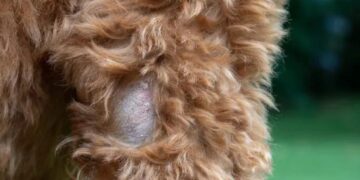Table of Contents
Part I: The Siege – A War I Was Losing
Section 1.1: My Name is Dr. Anya Sharma, and I Almost Failed My Own Dog
My name is Dr. Anya Sharma, and I’m a veterinarian.
For years, I’ve dedicated my life to the health and well-being of animals.
But nothing in my training prepared me for the war I would wage for my own dog, a magnificent Siberian Husky named Kael.
When he came into my life, he was a whirlwind of blue-eyed energy and pure joy.
His presence filled my home with a vitality I hadn’t realized was missing.
We were inseparable, our days a blur of long hikes, park adventures, and quiet evenings.
Then, the siege began.
It started subtly, an occasional scratch behind the ear.
I dismissed it.
But soon, the scratching became frantic, incessant.
The gentle jingle of his collar was replaced by the constant, maddening sound of his tags rattling as he chewed his paws raw.1
The “cone of shame,” a temporary tool in my clinic, became a permanent fixture in our home.
I’d lie awake at night, listening to his muffled whimpers and the thumping of his leg against the floor, my heart breaking with each sound.2
The shame was a heavy cloak.
Here I was, a doctor of veterinary medicine, armed with textbooks, modern diagnostics, and a pharmacy of treatments, yet I was powerless to bring my own dog relief.
We ran the conventional playbook.
First, we suspected a food allergy.
We switched his protein, moving from chicken to salmon, a common first step many frustrated owners take.3
Nothing changed.
We tried expensive, veterinarian-prescribed hydrolyzed protein diets.
He’d nose at the bowl, look up at me with those pleading eyes, and walk away.
The cost was exorbitant, and even the literature admitted it wasn’t a guaranteed fix.3
We cycled through vet visits, tests, and treatments, each one a fresh wave of hope that crashed into the same shore of disappointment.
I was living the same nightmare I saw in the eyes of my clients—the endless cycle of trial and error, the mounting bills, and the gut-wrenching feeling of failing the creature who depended on me completely.4
Section 1.2: The Blaring Alarms: A Vet’s Guide to Decoding Your Husky’s Distress Signals
In the midst of my despair, my clinical training kicked in.
I began documenting Kael’s symptoms not as a panicked owner, but as a diagnostician.
I started to see them not just as problems, but as alarms—distress signals from a body under siege.
If you have a Husky, these alarms might sound distressingly familiar.
Skin Manifestations: The Visible Battlefield
The most obvious sign of an allergic reaction in a dog is what it does to their skin, a condition broadly known as allergic dermatitis.5 This isn’t just simple “itching” (pruritus).
It’s a cascade of escalating damage.
It begins with red, inflamed skin (erythema) that is warm to the touch.
As the dog scratches, licks, and chews to soothe the unbearable itch, this can quickly lead to “hot spots”—angry, raw, weeping patches of skin also known as acute moist dermatitis.1 If the assault continues for weeks or months, the skin can thicken and darken in a process called lichenification, taking on a tough, elephant-like texture as a last-ditch effort to protect itself.1 Some dogs may also develop hives (urticaria), which are raised, itchy welts that can appear suddenly after exposure to an allergen.5
Location, Location, Location: Where the Battle Rages
While allergies can affect any part of the body, in Huskies, the battle is often concentrated in specific areas.
Pay close attention to their paws (especially between the toes), their ears, muzzle, underbelly, groin, and armpits.8 You’ll see them obsessively licking their paws, which can lead to saliva staining the fur a reddish-brown color, or rubbing their face on furniture to relieve the itch.7
The Ears Tell a Story: A Critical Outpost
One of the most common and frequently misunderstood signs of underlying allergies is chronic ear infections (otitis externa).
If your Husky constantly has red, smelly, waxy ears, and you find yourself treating infection after infection, it is highly probable that you are not dealing with a simple ear problem.
You are seeing a localized flare-up of a systemic allergic condition.1 The head shaking and ear scratching are just another blaring alarm.
Beyond the Skin: The Hidden Casualties
The war isn’t just fought on the skin.
An immune system in overdrive can cause collateral damage throughout the body.
- Gastrointestinal Issues: Allergic reactions, particularly to food, can manifest as vomiting, chronic gas, or intermittent diarrhea.6 That “soft poop” many owners struggle with can be a direct sign of the internal turmoil.3
- Respiratory Symptoms: While less common in dogs than in humans, some allergic dogs may experience sneezing, coughing, or watery eyes and nose discharge.1
- Behavioral Changes: Constant discomfort takes a toll. A dog in the throes of an allergic flare-up may become lethargic, withdrawn, or uncharacteristically irritable.6 The happy-go-lucky companion you know disappears, replaced by a shadow of their former self, exhausted by the endless itch.8
Section 1.3: Misguided Defenses: Why Our Standard Allergy Weapons Keep Failing
Understanding the alarms is one thing; silencing them is another.
The conventional arsenal of veterinary medicine is powerful, but as I learned with Kael, it’s often aimed at the wrong target.
These treatments are designed to suppress the symptoms, not resolve the underlying cause, which is why so many owners find themselves in a frustrating, expensive, and seemingly endless loop.
The Steroid Trap: Silencing the Alarms, Ignoring the Fire
Corticosteroids (like prednisone) are potent anti-inflammatory drugs.
They are incredibly effective at stopping the itch, sometimes within hours.
But they are the strategic equivalent of cutting the wires to the fire alarm while the building burns down.
They silence the symptom—the inflammation and itch—but do absolutely nothing to address the source of the fire.10 While necessary for controlling severe, acute flare-ups, long-term use comes with a host of serious side effects, including increased thirst and urination, weight gain, and most critically, suppression of the very immune system we need to function properly.
This is why modern veterinary medicine is increasingly moving away from steroids as a long-term solution for allergies.11
Targeted but Temporary: The Modern Marvels of Apoquel & Cytopoint
In recent years, two innovative drugs have revolutionized allergy management: Apoquel and Cytopoint.
I use them in my practice, and they can be lifesavers for providing immediate relief.
- Apoquel (oclacitinib) is an oral tablet that works as a Janus kinase (JAK) inhibitor. It precisely blocks the signaling pathway inside cells that leads to itch and inflammation.13
- Cytopoint is an injectable monoclonal antibody. It’s a biological therapy, not a chemical drug, that specifically targets and neutralizes a single protein called Interleukin-31 (IL-31), which is a key messenger that tells the brain to feel the sensation of itch.11 An injection can provide relief for 4 to 8 weeks.
These treatments are brilliant feats of pharmacology.
They are far safer for long-term use than steroids and are incredibly effective at what they do.
But we must be clear about what they do: they are highly sophisticated ways of silencing the alarms.
They block the message of itchiness from being received.
They provide peace and comfort, which is invaluable, but they do not rebuild the crumbling fortress walls.
They manage the crisis but do nothing to prevent the next one from occurring the moment the drug wears off.
The Elimination Diet Dead End: Identifying a Trigger, Not the Cause
The gold standard for diagnosing a food allergy is the elimination diet trial.11 This involves feeding a dog a “novel” protein and carbohydrate (like duck and potato) or a hydrolyzed diet for 8-12 weeks to see if symptoms resolve.
If they do, you slowly reintroduce old ingredients one by one to see which one causes a reaction.12
This process is grueling, expensive, and requires perfect compliance—no treats, no table scraps, no flavored medications.
And even when it “succeeds” and you identify that your dog reacts to chicken, it leaves the most important question unanswered: Why? Why is your dog’s immune system suddenly treating a common food protein like a deadly invader? A healthy dog can eat chicken without issue.
Identifying the trigger doesn’t fix the faulty immune response.
It just gives you a list of things to avoid, a list that often grows longer over time as the hypersensitive immune system finds new targets.4
This is the very heart of the cycle of frustration.
We chase symptoms.
We suppress alarms.
We identify triggers.
But the underlying vulnerability remains.
The treatments provide temporary peace, but the war rages on, just beneath the surface, waiting for the next opportunity to break through.
This realization—that the entire conventional approach was focused on managing the battle instead of winning the war—was the beginning of my breakthrough.
Part II: The Epiphany – It’s Not the Skin, It’s the Walls
Section 2.1: The “Aha!” Moment: Introducing the Fortress Immunity Paradigm
I hit my lowest point one evening, watching Kael miserably trying to scratch an itch inside his cone.
I felt like a complete failure, both as a vet and as his guardian.
In that moment of desperation, I turned away from my veterinary texts and dove into a different field: human immunology, specifically the burgeoning research on the gut-brain-skin axis.
I spent weeks reading papers on microbial communities, intestinal permeability, and systemic inflammation.
And then, it hit me.
An epiphany so clear and powerful it changed everything.
I had been fighting the wrong war.
The problem wasn’t Kael’s skin.
The problem wasn’t the pollen in the air or the chicken in his bowl.
The problem was his body’s entire defense system.
His fortress was compromised.
To understand what’s happening to our allergic Huskies, we need to stop thinking about the skin in isolation and start thinking about the immune system as a whole.
The best way I’ve found to explain this is the Fortress Immunity paradigm.
Imagine your dog’s body is a medieval fortress.16
The immune system is the army that defends it.
This army’s most critical job is to differentiate between “self” (the citizens of the fortress) and “not-self” (invaders like viruses and harmful bacteria).17
A healthy immune system is a disciplined, intelligent army.
It identifies true threats and eliminates them efficiently without harming the fortress itself.
An allergy is a sign that this army has gone haywire.
It’s in a state of hyper-reactivity.
The sentinels are panicked, firing arrows at everything that moves—invaders, supply wagons, even the fortress’s own citizens.
This is what we call an autoimmune reaction or a hypersensitivity.9
The constant itching, inflammation, and infections are the sounds and smoke of this internal civil war.
The critical question isn’t “What are the sentinels shooting at?” but “
Why are they so panicked in the first place?” The answer is simple: because the fortress walls have been breached.
Section 2.2: The Fortress Walls: Leaky Gut, the Secret Driver of Your Husky’s Allergies
The main wall of your dog’s immune fortress is the lining of their intestines.
This barrier, which covers more than 70% of the immune system, is a masterpiece of biological engineering.18
In a healthy gut, the cells that make up this wall (enterocytes) are bound together by “tight junctions.” Think of it as a perfectly mortared stone wall.19
This wall is selectively permeable.
It has tiny, guarded gates that allow fully digested nutrients—the fortress’s vital supplies—to pass through into the bloodstream.
At the same time, it is designed to keep invaders like toxins, pathogens, and large, undigested food particles securely contained within the gut to be safely escorted out of the body.20
“Leaky Gut Syndrome,” or more accurately, increased intestinal permeability, is what happens when this wall is damaged.21
The tight junctions break down, the mortar crumbles, and the wall becomes “leaky”.22
This damage can be caused by a number of modern insults:
- Poor Diet: Diets high in processed foods, carbohydrates, and inflammatory ingredients can constantly irritate the gut lining.23
- Medications: Common drugs like antibiotics, steroids, and even non-steroidal anti-inflammatory drugs (NSAIDs) can disrupt the gut environment and damage the intestinal wall.21
- Chronic Stress: Just like in humans, prolonged stress can have a physical impact, weakening the gut barrier.23
- Toxins: Environmental toxins from pesticides on grass to chemicals in household cleaners can contribute to the damage.22
When the wall is breached, these invaders—undigested food proteins, bacterial toxins, and other antigens—leak through the gaps and pour directly into the bloodstream.25
Imagine enemy soldiers streaming through a hole in the fortress wall.
The immune system, seeing these foreign particles where they absolutely do not belong, does exactly what it’s supposed to do: it panics and launches a massive, body-wide inflammatory attack.21
This is the secret engine of your Husky’s allergies.
The chronic, low-grade inflammation triggered by a leaky gut puts the entire immune system on high alert, making it hyper-reactive to everything.
The skin isn’t the source of the problem; it’s just one of the most visible battlefields where this systemic inflammation manifests.24
Section 2.3: The Microbiome: The Loyal Gatekeepers of the Fortress
The fortress wall doesn’t stand alone.
It is guarded, maintained, and informed by trillions of loyal gatekeepers: the gut microbiome.
This complex community of bacteria, fungi, and other microbes living in the intestines is not just a passive resident; it is an active and essential organ of the immune system.26
A healthy, diverse microbiome is like a legion of well-trained, loyal gatekeepers.
They perform critical jobs for the fortress 28:
- They train the army: The microbiome helps “educate” the immune cells, teaching them to distinguish between friend and foe, thereby preventing over-reactions.29
- They reinforce the walls: They help digest food and produce beneficial compounds, like short-chain fatty acids, that nourish the cells of the intestinal wall, keeping the mortar strong.24
- They fight off invaders: A thriving community of good bacteria crowds out and fights off pathogenic bacteria, acting as a first line of defense.26
Dysbiosis is the term for what happens when this community of gatekeepers falls into imbalance.
When the good bacteria are wiped out (often by antibiotics or poor diet) and harmful bacteria are allowed to take over, the entire defense system is weakened.24
This imbalance contributes directly to the breakdown of the fortress walls (leaky gut) and the subsequent panic of the immune army.27
Scientific studies have confirmed this link, showing significant differences in the gut microbial communities of allergic dogs compared to healthy dogs.30
Section 2.4: Reframing the Enemy: Allergens as Opportunistic Invaders
This understanding completely reframes our concept of an “allergen.” The conventional view holds that the allergen—the pollen, the dust mite, the beef protein—is the enemy.
The solution, therefore, is to avoid the enemy at all costs.
But this approach is flawed because it ignores the central question: why does one dog’s immune system see beef as an enemy while another sees it as dinner?
The Fortress Immunity paradigm provides the answer.
The beef protein is not the true enemy.
It is merely an opportunistic invader that is taking advantage of a pre-existing vulnerability—the breached walls and panicked army of a compromised immune system.
A healthy fortress with strong walls and wise gatekeepers can handle the occasional supply wagon of beef protein or a bit of pollen dust in the air.
It recognizes them as harmless and lets them pass.
But a fortress with leaky walls and panicked sentinels sees that same beef protein leak into the bloodstream where it doesn’t belong and screams “INVASION!” The problem isn’t the beef; it’s the state of the fortress.
This is why simply switching foods or trying to create a sterile, allergen-free bubble around our dogs is a losing battle.
We are focusing on the triggers, not the root cause.
The true enemy is the internal state of immune dysregulation originating in the gut.
A Husky-Specific Clue: The Zinc Connection
Nowhere is this gut-skin connection more evident than in a condition that specifically affects Siberian Huskies: zinc-responsive dermatosis.9 This condition, which perfectly mimics the symptoms of allergies—crusty lesions, hair loss, and itchy skin—is not an allergy at all.
It is caused by a genetic defect in some Huskies that prevents them from properly absorbing the essential mineral zinc from their gut.9 The result is a skin disease that originates entirely from a dysfunction within the digestive tract.
This breed-specific vulnerability is a powerful, real-world confirmation of our core principle: for a Husky, skin health is a direct, undeniable reflection of gut health.
To heal the skin, you must first heal the gut.
Part III: Rebuilding the Fortress – A Practical Guide to Lasting Peace
Realizing that Kael’s fortress was crumbling from the inside out was my epiphany.
But an epiphany without a plan is just an idea.
The next step was to develop a practical, step-by-step protocol to stop the assault, repair the walls, and restore order to his immune system.
This is the protocol that finally brought Kael—and me—lasting peace.
It’s not a quick fix, but a systematic rebuilding of your dog’s health from the inside O.T.
Table 1: The Fortress Immunity Protocol: At a Glance
| Fortress Goal | Key Action | Tools & Tactics |
| Cease Fire & Assess | Stop the Ongoing Damage & Calm Inflammation | Remove processed foods, unnecessary meds, toxins. Implement a temporary “Rescue Diet” with cooling/novel proteins. |
| Step 1: Repair the Walls | Heal the Leaky Intestinal Lining | L-Glutamine, Demulcent Herbs (Slippery Elm, Marshmallow Root), Digestive Enzymes. |
| Step 2: Repopulate the Gatekeepers | Restore a Healthy, Diverse Microbiome | High-quality, multi-strain, dog-specific Probiotics; Prebiotic fiber; Fermented foods (goat’s milk kefir). |
| Step 3: Supply the Garrison | Provide Long-Term Anti-Inflammatory Nutrition | Fresh, species-appropriate diet (raw or gently cooked); Rotation of cooling proteins; Omega-3 Fatty Acids (fish oil). |
Section 3.1: Cease Fire and Assess the Damage: Stopping the Assault
Before you can rebuild a fortress, you must first stop the cannonballs from hitting the walls.
The initial phase is about removing the major sources of inflammation and giving the body a chance to calm down.
- Stop Adding to the Problem: This is the most critical first step. You must eliminate the things that are actively damaging the gut wall and fueling the fire of inflammation.
- Eliminate Processed Foods: Stop feeding kibble and other highly processed foods. These are often packed with carbohydrates (which fuel harmful bacteria), preservatives, and inflammatory ingredients like lectins and gluten that constantly irritate the gut.22
- Review Medications: Work with your veterinarian, ideally one with a holistic or integrative perspective, to assess every medication your dog is on. Drugs like antibiotics, steroids, and even flea/tick medications can be harsh on the gut.21 The goal is to use them only when absolutely necessary and to find natural alternatives where possible.
- Detoxify the Environment: Reduce your dog’s exposure to environmental toxins. Avoid using pesticides or herbicides on your lawn, switch to pet-safe household cleaners, and be mindful of things like scented candles and air fresheners.22
- The Rescue Diet: For the first 6 to 8 weeks, I recommend a temporary, simplified, anti-inflammatory diet to reset the system.25 The goal is to provide easily digestible nutrition that won’t trigger the already hypersensitive immune system. This typically involves feeding a single novel protein—one your dog has never had before. Focus on “cooling” proteins known to be less inflammatory, such as duck, rabbit, or cod. Pair this with a simple, low-glycemic vegetable. This dietary “cease fire” gives the gut a much-needed rest and reduces the overall inflammatory load on the body.
Section 3.2: Step 1: Repairing the Walls (The Leaky Gut Protocol)
With the initial assault halted, it’s time to bring in the masons and start repairing the crumbling fortress walls.
This involves providing the specific nutrients the intestinal lining needs to heal and regenerate.
- L-Glutamine (The Building Blocks): This amino acid is the primary fuel source for the cells lining the intestines.21 Supplementing with L-glutamine provides these cells with the raw materials they need to rebuild, repair damage, and tighten those crucial “zipper-like” junctions between them.20
- Demulcent Herbs (The Soothing Mortar): Two herbs are invaluable here: Slippery Elm and Marshmallow Root. These are known as demulcents because they contain a substance called mucilage.22 When mixed with water, mucilage forms a soothing, gel-like coating that lines the entire digestive tract. This protective layer reduces irritation from stomach acid and undigested food, calms inflammation, and gives the underlying cells a safe environment in which to heal.21
- Digestive Enzymes (The Support Crew): Often, a damaged gut doesn’t produce enough of its own enzymes to break down food properly. Adding a high-quality digestive enzyme supplement helps ensure that food is fully broken down before it reaches the small intestine. This reduces the burden on the gut and minimizes the chance of large, irritating food particles contributing to inflammation.25
Section 3.3: Step 2: Repopulating the Gatekeepers (Microbiome Restoration)
As the walls are being repaired, you must simultaneously recruit and train a new legion of loyal gatekeepers.
Restoring a diverse, balanced gut microbiome is essential for long-term immune stability.
- Probiotics (The New Recruits): Probiotics are live, beneficial bacteria that help recolonize the gut. It is crucial to use a high-quality, multi-strain probiotic specifically formulated for dogs.18 Look for products containing beneficial strains like
Lactobacillus and Bifidobacterium. Avoid dairy-based probiotics, as dairy can be an allergen for many dogs, and be cautious with certain strains that can sometimes exacerbate issues in sensitive individuals.24 The goal is to flood the gut with good guys to crowd out the bad. - Prebiotics (Food for the Troops): Probiotics are living organisms; they need to eat. Prebiotics are specific types of fiber that are indigestible to your dog but are the preferred food source for beneficial gut bacteria.24 Adding prebiotic-rich foods like dandelion greens, asparagus, or a small amount of banana can help your new probiotic recruits thrive and establish a strong colony.18
- Fermented Foods (The Natural Allies): Small amounts of fermented foods can be a powerful, natural source of probiotics. A spoonful of goat’s milk kefir (which is better tolerated than cow’s milk dairy) or fermented vegetables can introduce a wide variety of beneficial bacteria to the gut ecosystem.22
Section 3.4: Step 3: Supplying the Garrison (The Long-Term Anti-Inflammatory Diet)
Once the walls are repaired and the gatekeepers are in place, the final step is to establish a sustainable supply chain that nourishes the fortress for life.
This means transitioning to a permanent diet that supports gut health and minimizes inflammation.
- The Philosophy: Fresh and Species-Appropriate: The ideal long-term diet is one made from fresh, whole foods, either raw or gently cooked. This approach eliminates the processing, preservatives, and high carbohydrate content of kibble that contribute to gut inflammation.24 It provides nutrients in their most bioavailable form.
- Protein Rotation and “Temperature”: It’s wise to rotate between several different proteins to ensure a broad spectrum of nutrients and prevent the development of new sensitivities. Pay attention to the Traditional Chinese Medicine concept of food “temperatures.” For a dog prone to inflammation (a “hot” condition), focus primarily on “cooling” proteins like duck, rabbit, cod, and turkey. Use “neutral” proteins like beef and bison in moderation. Be cautious with “warming” or “hot” proteins like chicken, lamb, and venison, as these can be more inflammatory for sensitive dogs.25
- Omega-3 Fatty Acids (The Fire Brigade): Omega-3 fatty acids, particularly EPA and DHA found in high-quality fish or krill oil, are one of the most powerful natural anti-inflammatories you can give your dog.15 A daily dose of omega-3s helps to keep systemic inflammation in check, supporting not only skin health but also joint, brain, and heart health.28
This protocol is a journey, not a destination.
It requires patience and commitment, but by addressing the root cause of the immune dysfunction, you are not just managing symptoms—you are fundamentally rebuilding your dog’s health and resilience from the ground up.
Part IV: A New Era of Peace
Section 4.1: Debunking the Myths That Keep Our Huskies Sick
Embarking on this healing journey requires not just a new protocol, but a new mindset.
Part of that is actively dismantling the pervasive myths about dog allergies that keep so many owners stuck in the cycle of frustration.
These misconceptions can derail progress and lead us down the wrong path.
Myth 1: “Hypoallergenic” Dogs Exist.
- The Fiction: There are certain breeds, sometimes including Huskies, that are marketed as “hypoallergenic” and safe for allergic people.
- The Fact: This is unequivocally false. No dog breed is 100% hypoallergenic.32 Pet allergies are not caused by hair, but by specific proteins found in an animal’s dander (skin flakes), saliva, and urine. All dogs, even hairless ones, produce these proteins.33 While some dogs may shed less, potentially releasing fewer dander-covered hairs into the environment, they are still producing the allergens. The idea of a truly hypoallergenic dog is a marketing myth.
Myth 2: Grain-Free Diets Cure Allergies.
- The Fiction: Switching to a grain-free kibble is the solution for a food-allergic dog.
- The Fact: This is one of the most damaging myths in pet nutrition. First, as we’ve established, true food allergies are far less common than environmental allergies.12 Second, when food allergies
do occur, the most common culprits are animal proteins—like beef, chicken, and dairy—not grains.12 A grain-free kibble can still be loaded with the very protein your dog is reacting to. Furthermore, it is still a highly processed food, often high in other starchy fillers like peas or potatoes, which can continue to fuel gut inflammation and dysbiosis.24
Myth 3: Food Allergies are the Most Common Type.
- The Fiction: If a dog is constantly itching, it must be allergic to its food.
- The Fact: The most common allergy in dogs is actually flea allergy dermatitis, where a single fleabite can cause a massive reaction.12 The second most common is atopy, or environmental allergies to things like pollens, molds, and dust mites. True food allergies are relatively rare, affecting only a small percentage of dogs.12 Many conditions diagnosed as “food allergies” are more accurately described as food
intolerances—the direct result of a leaky gut that can no longer properly process certain ingredients.
Myth 4: Allergy Testing is a Definitive Diagnostic Tool.
- The Fiction: A simple blood or skin test will tell you exactly what your dog is allergic to, solving the mystery.
- The Fact: Allergy testing has significant limitations. Both blood tests (serology) and skin tests (intradermal testing) can have high rates of false positives and false negatives. Their best and most reliable use is not for diagnosing an allergy, but for identifying specific environmental allergens to include in a custom-formulated immunotherapy serum (allergy shots) for a dog already diagnosed with atopy.7 They are not a simple answer key and should not be the first step in an allergy investigation.
Section 4.2: Conclusion: Kael’s Story and Your Path Forward
As we diligently followed the Fortress Immunity protocol, the changes in Kael were slow, then sudden.
The first thing I noticed was a shift in his energy.
The lethargy lifted, and the playful spark returned to his eyes.
Then, the frantic scratching began to subside.
The angry red patches on his belly faded to pink, then to pale white.
The hair on his paws, once chewed down to stubble, started to grow back in its thick, downy-soft texture.
The day I took off his cone for good and watched him go a full 24 hours without obsessively chewing or scratching felt like a miracle.
It wasn’t.
It was the result of a paradigm shift—of stopping the war against his symptoms and instead, focusing all our efforts on rebuilding his body’s natural defenses from the inside O.T.
Today, Kael is a different dog.
He is vibrant, healthy, and comfortable in his own skin.
We still live in the real world with pollen and dust, and he eats a varied diet of fresh foods.
His fortress is now strong enough to withstand these everyday challenges without sounding the alarms of a full-blown allergic reaction.
His journey taught me a profound lesson that has reshaped how I practice veterinary medicine.
The goal is not to create a sterile, allergen-free bubble for our dogs, an impossible and joyless task.
The goal is to cultivate such robust internal health—a fortress so strong, with walls so sound and gatekeepers so wise—that the immune system remains calm, balanced, and resilient in the face of life’s inevitable exposures.
If you are reading this, you are likely where I once was: exhausted, frustrated, and desperate for an answer.
I want you to know that there is hope.
The path forward is not about finding the next drug or the next “magic” food.
It is about understanding the true nature of the problem and committing to the patient, logical work of healing the gut.
It is a journey of rebuilding, but it is a journey that leads to lasting peace—for your beloved Husky, and for you.
Works cited
- Dog Allergies: Types, Symptoms, and Treatments – GoodRx, accessed August 13, 2025, https://www.goodrx.com/pet-health/dog/seasonal-allergies
- I Found Out I Had Severe Pet Allergies After I Adopted my Dog. Here’s How I Beat Them., accessed August 13, 2025, https://www.rover.com/blog/true-story-pet-allergies/
- Food allergies : r/husky – Reddit, accessed August 13, 2025, https://www.reddit.com/r/husky/comments/1241ght/food_allergies/
- An Allergy Story – Rewarding Pet Nutrition, accessed August 13, 2025, https://rewardingpetnutrition.com/an-allergy-story/
- Allergies in Dogs: Signs, Symptoms, Treatments – American Kennel Club, accessed August 13, 2025, https://www.akc.org/expert-advice/health/dog-allergies-symptoms-treatment/
- 6 Symptoms of Allergic Reactions in Dogs and How to Help Your Pet | Altadena Pet Hospital, accessed August 13, 2025, https://myaltadenavet.com/blog/allergic-reaction-in-dogs-symptoms/
- Dog Seasonal Allergies: Symptoms and Treatment | PetMD, accessed August 13, 2025, https://www.petmd.com/dog/conditions/skin/seasonal-allergies-dogs
- Does Your Husky Have Allergy Symptoms? – Jiminy’s, accessed August 13, 2025, https://jiminys.com/blogs/benefits/does-your-siberian-husky-have-allergies
- 4 Common Husky Skin Problems | Vetericyn, accessed August 13, 2025, https://vetericyn.com/blog/husky-skin-problems/
- Unravelling the myth of allergies in dogs | Dr. Peter Dobias, accessed August 13, 2025, https://peterdobias.com/blogs/blog/11808633-unravelling-the-myth-of-allergies-in-dogs
- Dog Allergy Relief at The Hometown Veterinarian | The Hometown …, accessed August 13, 2025, https://www.hometownveterinarian.com/services/dogs/dog-allergy-relief
- 7 Common Myths About Pet Allergies Debunked – Vet In Lebanon …, accessed August 13, 2025, https://lebanonanimalhospital.com/7-common-myths-about-pet-allergies-debunked/
- Revolutionizing animal care – Zoetis, accessed August 13, 2025, https://www.zoetis.com/news-and-insights/blog/revolutionizing-animal-care
- Revolutionizing Canine Allergy Management – Deer Park Veterinary Hospital, accessed August 13, 2025, https://www.dpvh.net/services/blog/revolutionizing-canine-allergy-management
- Husky with Skin Allergies, accessed August 13, 2025, https://www.nomnomnow.com/learn/article/husky-skin-allergies
- The Healthy – Properly Functioning Canine Immune System – Whole …, accessed August 13, 2025, https://www.whole-dog-journal.com/health/the-healthy-properly-functioning-canine-immune-system/
- Supporting Your Dog’s Immune System – Whole Dog Journal, accessed August 13, 2025, https://www.whole-dog-journal.com/care/supporting-your-dogs-immune-system/
- Dog Gut Health And Allergies: Symptoms And Solutions, accessed August 13, 2025, https://thenaturaldogstore.com/blogs/health/dog-gut-health-and-allergies
- Leaky Gut Syndrome in Dogs: A Complete Guide – Supreme Source, accessed August 13, 2025, https://www.supremesourcepet.com/blogs/news/dog-leaky-gut
- Leaky Gut Syndrome in Dogs | VCA Animal Hospitals, accessed August 13, 2025, https://vcahospitals.com/know-your-pet/leaky-gut-syndrome-in-dogs
- Leaky Gut In Dogs: A Growing Epidemic – Dogs Naturally, accessed August 13, 2025, https://www.dogsnaturallymagazine.com/leaky-gut-syndrome-in-dogs/
- Leaky Gut in Dogs – Adored Beast, accessed August 13, 2025, https://blog.adoredbeast.com/leaky-gut-in-dogs/
- Understanding Leaky Gut in Dogs: Symptoms, Causes, and Treatment – Buddy & Lola, accessed August 13, 2025, https://www.buddyandlola.co.uk/blogs/news/understanding-leaky-gut-in-dogs-symptoms-causes-and-treatment
- Dog Gut Health And Allergies: The Leaky Gut Epidemic – Dogs Naturally, accessed August 13, 2025, https://www.dogsnaturallymagazine.com/why-your-dogs-allergy-treatment-doesnt-work/
- Itchy and Sneezy: Decoding Your Dog’s Spring Allergy Symptoms and Healing Solutions, accessed August 13, 2025, https://www.volharddognutrition.com/dog-allergy-symptoms-healing-solutions
- Skin problems in dogs and the intestinal microbiota – Vets & Clinics, accessed August 13, 2025, https://vetsandclinics.com/en/skin-problems-in-dogs-and-the-intestinal-microbiota
- What you need to know about allergies and the gut microbiome – BIOME9, accessed August 13, 2025, https://biome9.com/blogs/b9-journal/the-microbiome-and-allergies
- The Tie Between Your Dog’s Gut Health and Their Itching | Zoetis Petcare, accessed August 13, 2025, https://www.zoetispetcare.com/blog/article/dog-gut-health-itching
- How Gut Health Impacts Seasonal Allergies And Digestion In Dogs, accessed August 13, 2025, https://seaweedfordogs.com/pages/how-gut-health-impacts-seasonal-allergies-and-digestion-in-dogs
- A Randomized Controlled Trial to Evaluate the Impact of a Novel Probiotic and Nutraceutical Supplement on Pruritic Dermatitis and the Gut Microbiota in Privately Owned Dogs – PubMed Central, accessed August 13, 2025, https://pmc.ncbi.nlm.nih.gov/articles/PMC10854619/
- The Skin Microbiome in Healthy and Allergic Dogs | PLOS One – Research journals, accessed August 13, 2025, https://journals.plos.org/plosone/article?id=10.1371/journal.pone.0083197
- The Truth About Pet Allergies, accessed August 13, 2025, https://www.aaaai.org/tools-for-the-public/conditions-library/allergies/pet
- Hypoallergenic Dogs and Dog Allergies: Myths, Facts and What you Should Know, accessed August 13, 2025, https://www.aaaai.org/tools-for-the-public/conditions-library/allergies/dog-myths
- The Top 10 Allergy Myths Debunked, accessed August 13, 2025, https://familyallergy.com/education/allergy/top-10-allergy-myths/






